|
The biggest river of the Adriatic gathering ground, although greatly
curbed and fettered, is still with is't beauty and landscape variety
unique. Within it's delta, the river conditioned totally unique way
of human living which today slowly disapeares but it is very much
present in the memories of older inhabtants, their stories and in
conscience of the young people who don't want to let this to be
forgotten.
The valley of Neretva's lower flow has biggest and most valuable
rests of the Mediterranean wetlands on east Adriatic coast and this
is one of the rare areas in the whole Europe. Lately, this wetland
areas were very much degraded and the rest of this areas are like
fractured separated islandes with intensive worked out and inhabited
surrounding. Water regulations, upper part acumulation building and
drainage and converting of the wetland into agriculture land have
changed look of this area irreversible. Former spatial cane parts
and lagoons valuable for wintering and moving of extremly various
bird world so as for feeding and berry of the fishes are today only
rests and people with different human activities are continuing in
jeopardizing of this area.
However this area has even in it's present condition, in aspect of
keeping of the biological and landscape variety, international
importance. As that lower flow of neretva is part of the Ramsar
list-Converntion about wetlands protection and in program Important
Bird Areas which is conducted by the BirdLife International.
Natural unit of the Neretva's lower flow is formed by a valley with
last 30 km of the river's flow. After the tributaries Trebižat and
Bregava basin, the valley spreads suddenly and forms alluvial area
"Neretvanska blatija" cca 20.000 ha. Upper part is area Hutovo
blato, dependent from water system of the river Krupa, while in the
lower part which is in Republic Croatia, Neretva spreads into more
branches forming spatial delta.
It is understandable that in aspect of the nature protection this is
uniqu area for which should be secured common directioning plan
based on the perfect approach and transbordary cooperation.
Hutovo blato
Hutovo blato sweeps on almst 8.000 ha Neretva's valley in
Bosnia and Herzegovina. Through this area flows river Krupa,
Neretva's tributary, which with underground waters of the edge karst
area determinates water system and by that total life conditions in
this wetland ecological system. Relief, climate, vegetation and
plenty of water are creating during the whole year favourable life
conditions for a great number of the plant and animal and especially
bird species.
Hutovo blato is important for wintering of the goose birds and
woodcocks and for nesting of the European jeopardized species, as
different herons or for instance litlle sparrow. Thanks to spatial
wet areas and different wetland life areas and to favourable
influences of the Mediterranean climate, hutovo blato is during
winter advantageously area for ducks and many other bird species
from north part of the Europe. 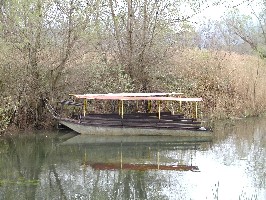
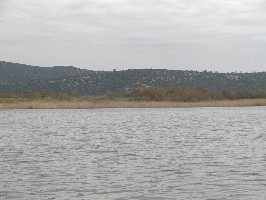
Limestone clif "Ostrvo"
splits Hutovo blato to upper (Deransko) and lower (Svitavsko) part.
In the upper part there are six lakes and the biggest is Deransko.
This area is still relativly preserved from human influence and it's
important area for many plant and bird species.
Former spatial wetland Svitavsko blato was converted in 1979 during
hydroelectric power station building into spatial acumulation lake
cca 1.300 ha. Lake water submerged former large wetland vegetation
areas with fluviall meadow and fluviall willow and white poplar
forests.
That has significantly decreased bird na dfish species number.
Ornitological investigation warned on great quantitiy and quality
changes of the structure of bird species comparing with status
before 1979. Number of birds that depend on wetland vegetation
(ducks) and fluviall meadows (woodcocks and lapwings) was especially
decreased. international importance of this migrate bird area is
significant decreased.
Water affluence and it's connection with sea over Neretva and Krupa
makes possible for rich fish world to survive here in Hutovo blato.
This place is known for very long through it's eel and carp
mariculture. Unfortunately, today the fish fund is very much poored.
Significantly changed Neretva's and it's tribtaries water systems
and especially violating of the natural balance by building of
hydroelectric power station Čapljina, have also disordered
migrations and structure of the fishes. Artery of the hutovo blato
is river Krupa which leads waters from Deransko and Svilavsko area
into Neretva. The river doesn't have real well, it's coming from
Deransko area and it has serpentine flow. That very special river
can flow in both direction. When Neretva has high water-gauge Krupa
brings water to Deransko area and flows sorrounding areas.
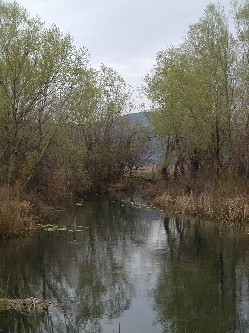
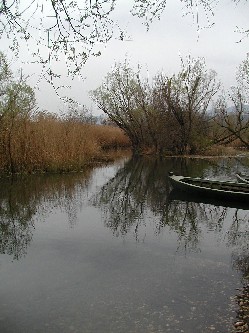
In 1995. Hutovo blato bacames protected as nature park under control
of the Public company Hutovo blato. In the one part of the
park hunting and fishing are allowed and into ecological system is
imported few foreign species which disordered relations in
ecological system. Acumulations in Neretva's upper flow are
conditioning dynamic of the water system which frequently is not in
harmony with with season needs of the of the living world on this
area. Assorted planning of all future activities within unique
directionong plan seems to be more and more desirable.
Neretva's delta
Neretva's delta in Republic Croatia contains around 12.000 ha. From
former 12 creeks which were branched through delta after many
meliorations today there are only two creeks. Also belonging
wetlands, numerous lakes and lagoons are gone. Today are on that
cultivated area fractured rests of the former unique Mediterrenean
wetlands preserved. Five localities with total 1.620 ha surface are
protected in categories of ornitological reservation
(Pod Gredom, Prud and Orepak), ornitological-ichtiological
reservation
(Delta Neretva), and protected landscape (Modro oko and
Desne lake).The whole area is predicted for protection in the nature
park category.
Natural values and variety of the inhabit areas are here depended on
water system which is conditioned by the river Neretva. Thanks to
underground karst flows of the basin area on the boundary area, with
surrounded limestone field, there are large number of wells which
are bringing significant quantities of water especially in winter.
Underground water which is coming from that marginal area goes to
nemerous brooks, lakes and rivers. Many caves and other underground
inhabit areas in surrounding karst have rich fauna with many endemic
features.
For the delta is also significant influence of the sea. Areas with
brackish water are special inhabit areas which are extra enrichening
for the biological variety of the entire area. Water inhabit areas
with spatial cane fields, wet meadows, sand beaches, reefs, salt
waters and marginal karst of the over- and underground are great
treasures of the inhabit areas, and that treasure is base for
appropriate variety of the herb and animal world.
Neretva's mouth is for great biological production feed area for
numerous fish species. Delta,
lagoons and brackish waters are hatcheries for fishes and crabs
which are spending rest of their life in the fresh or salt water.
They are aslo entrances and exits for fish migrations. Before
drainage of numerous lagoons the mouth was significantlly better for
feeding and hatching of the fishes-especially lake Modrić. But even
today mariculture is important resource for living and the people
from this areas are seeing this as accessory job.
Most of the catched species are
Merluccius merluccius and eels.
Unfortunately, fishing hasn't supervision and it's conducting
unsystematic and with unappropriate methods, so on this way already
poored fish funds are even more jeopardized.
In the Neretva's delta there are 310 bird species and 115 of them
are nesting birds. The area is primarily important as rest area for
bird migrations and wintering. The mouth is with shallows and reefs
the most valuable for migration of the Emberiza melanocephala, tops
and gulls. Cane fields and water surfaces are important for
migrations and wintering of the goose birds, and cane fields,
surrounding meadows and bush for different ginging birds. Here there
are nests some European jeopardized species like Botaurus stellaris,
Aythya nyroca and Charadrius alexandrinus, who makes
nests on sand beaches by Neretva's mouth and also
mustache arbor for which, this is only nest area in coast part of
Croatia. Cane fields are
important for nesting of the
Gallinago gallinago L. and
different species of Porzana pusilla and
Acrocephalus melanopogon.
After large meliorations conditions for wetland birds in Neretva's
delta are significantlly worse (inhabit areas disappearance,
intensive agriculture, unreasonable hunting). Birds quantitiy is
today significantlly decreased but the number of the species is
still large and valuable. Considering birds species structure and
delta's importance for bird migrations and wintering that area has
international importance.
With appropriate protection measures and managing plan which should
include revitalization of some inhabit areas and rigid hunting
regulation the condition might be much better.
Monumentary legacy
Neretva's lower flow is overflown with monumentary legacy which
testifys about milleniums of human presence. Through grabing of the
productive land from wetland and developing of the traffic ways
toward inside were also condition for colonies development created.
There are numerous prehistoric forts and colonies and also grave
batchs strayed on rises and lower parts near Neretva. It looks like
that on this area lived old Iliric tribes in the ironage. Antient
Greeks have founded in the 4th century emporium (harbour)
which developed into far known bargain place Narona, present Vid
near Metković. Through whole delta around Narona were strayed suburb
colonies and economy possessions whose remnants are today hided by
the wetland and river drifts. Rich monumentary legacy also testifys
about Roman time-city bulwarks with towers, Roman villas, mosaics,
epitaphs. In the emperor August's time Narona was administrative
center. 1996 in the Vid centre on the main square (Augusteum) were
digged out remnants of the temple where 16 statues of gods and
goddices were found. Between this statues impressive is emperor
August statue, 3 meters high.
Christianity can be followed from the middle of the 5th
century on the lower Neretva area. From early Christian legacy St
Vid basilica, with extraordinary conservated baptistery on today's
church in Vid place, is pointed out.
There are few conservated monumentaries from the Middleage. During
Turk attacks in the end of the 15th century some churchs
were demolished and mention to that time is impressive fort Norinska
tower, on the river Norin into Neretva mouth. Because of often wars
from the Venetian republic time there are not significant
monumentaries.
Traditional engineer building in the lower Neretva's flow has it's
specialities and it is also inserted into monumentary legacy of that
area. But people are leaving old buildings and they are becoming
ruins or they are unappropriated rebuilt.
Importancy of the archeological discoveries and monumentary legacy
needs to be appropriate valued and extraordinary possibilities of
tourism which is result of that should be used in the best way.
Neretva's lower
flow-sometimes and now
After the last glacial period the sea level had increased and the
sea submerged karst relief till today's Hutovo blato.
Neretva was inflicting the gravel left it in the valley. The wetland
was formed when Neretva filled sinked karst inlets with it's rich
drifts, and in that way Neretva hoited the ground. On the areas that
were on bigger distance from the river flow, where the drift was not
that strong, stayed wetland and lakes.
In the middle of this alluvial drifts today are emphasized single
mounds of the karst landscape.
The man began to conquer the wetland and put it under his needs
already in 19th century. Bigger regulations on Neretva
started in 1880 when the waterway to Metković was built. First
melioration form was so called ditching, canal digging which were
used for wringing of the wetland soil, and drafting of the digged
soil on the parcels. In that way the cultivable soil was created.
Hunting, fishing, cattle cultivation which were surviving on the
wetland vegetation, vineyardening and cultivation of the poor soil
were kinds of life in the Neretva's lower flow even before 50 years.
Everything was under water cycles and moving and the main vehicle
for this area were unique logs. From that little boats people
fished, picked grave, took care for the cattle which often hustled
through the water. The wedding and funeral ceremonies passed in the
logs on Neretva.
Bigger meliorations conducted in 1960-s brought drastical changes.
Beautiful Obrad Glušćević's movie People from Neretva is chronicle
of a hard but special way of life of the people from this area which
is only in the memories only of the oldest inhabitants. Touching
scene in the movie-funeral in the logs which are going down on the
Nereva watched through jaws of the mud-machine- is a simbolic
demonstrator of the dying of a way of living. That way of life is
dying because of the machines which are devouring the wetland.
Application of the modern soil cultivating methods, intensivitation
of the agriculture and initiation of the new cultures, conditioned
increasing of the life standard of people in the Neretva's delta.
The landscape was from dominantly wetland area transformed into
agriculture area with mandarine plantation. In the last ten years
the picture is changed again-the intensity of the agriculture is
weaking and many meliorated areas, without expensive maintaining
procedures ,are becoming spontaneus wetlands. Extraordinary
possibilities for the tourism and ecological agriculture considering
nature protection are not enough used. On the crossroad of the
future developments ways, it is neccessary to make a choice.
Area using
Negative influences of the human activity on the natural worths, are
the same in the whole area of the Neretva's lower flow. Inhabitants
are today concentrated in few bigger places. Metković, Opuzen
and Ploče are bigger centers in Republic of Croatia, and Čapljina on
the Bosnia and Herzegovina area.
In cooperation with experts of the international organization FAO in
1960-s 5.376 ha of the wetlands and lagoons in the Neretva's delta
were meliorated. with founding of the state company PIK Neretva new
conquered agriculture area was gradually cultivated. The wetland was
transformed into plantations, mostly mandarine plantations. Water
regime of this place and nearness of the sea (soil saltionation)
demanded constant application of very complex and expensive
hydr-melioration measures for maintaining of the existing condition.
Understandable, all that things went on harm of the wetland inhabit
areas. With this things formerly immeasurable treasure of the fish
and bird world was also decreased.
In a few last years, after crash of the famous PIK Neretva, and in
conditions of the difficult economy status, activities on soil
arrangement are gone and agriculture activities are decreasing.
Because of unsolved relationships in the area possessions, the
development of the agriculture is unsystematic and without
supervision. New cultivate areas are taken illegal forone's acount
of the wetland inhabit areas while the other areas are becoming,
because of neglect, wetland areas and natural plants are growing on
that areas. Use of pesticids and artificial fertilizers, which are
directly and undirectly polluting the water and jeopardizing water
and wetland flora and fauna, is also conducted without supervision.
Vine-economy activities have also, in last decades, affected the
nature on this areas. Activities were tight involved with the
development of the agriculture of this place (meliorations) and also
line of river regulations for flood defence was conducted. Great
disturbance of the water regime was caused by the five up-water
hydro-electric power stations in Bosnia and Herzegovina. Belonging
acumulations are keeping water and sediment and causing sudden
changes of the water level, or water lack, especially in the summer
months.
While the agriculture and water activities jeopardizing primarly
water and wetland inhabit areas meanwhile uncontrolled hunting and
fishing are directly jeopardizing tha fauna of this area. Welth of
the birds and fishes, which was basic for surviving of the
inhabitants, is significantlly decreased. The tradition of the
hunting and fishing is firmly rooted by the local inhabitants,
although they are aware that the bird and the fish fund is
jeopardized and it needs protection. Poachery is forbidden and
burnening of the cane fields in purpose of getting of the wide hunt
areas is not rare. Fishing also has similar problems. Canals are
being damed with nets and in this way the moving of the fishes is
being stopped and fishing is present even in protected reservation
area at Neretva's mouth.
Extraordinary tourism potential of this area is unfortunately almost
unused. It looks like that the development of the tourism, connected
with protection of the natural resources, could mark future
development of the Neretva's lower flow.
Nature protection
and future of the Neretva's lower flow?
Natural and landscape values in combination with rich and
extraordinary worth culture-historical legacy could become basic for
the development of the whole Neretva's lower flow area. It is
neccessary to plan intirely such development for the wide
overboundary area.
Hutovo blato is already protected
as nature park, while the Neretva delta area in Republic Croatia is
contemplated for the same category protection. Such protection, with
full appreciation of the development urgencies, trys to protect the
area from unreasonable economy using and building. Human activities
are placed in frames of the determinated general conditions and
constraints, so that basic natural values which are development
basic of this area could be saved.
Protection is based on zoning, that is on determination of the most
preserved and most valuable parts of nature which need rigid
protection regime, and of the surrounding areas with pronounced
human activities. This area needs to be controled on unique way so
that activity harmony of all users of this area could be insured, on
the basic of the special management plan.
However, it is neccessary to stop destroying of the rest wetland
inhabit areas, and some already destroyed revitalize, in Neretva's
delta..
Combination of the wetland-coast surrounding with culture-historical
legacy and specialities of the local way of life, needs to used as
potential for the tourism development on this areas. Up till now the
tourism concept for this area is not made. Meanwhile, in purpose of
preserving of natural values as development basic, it is obviously
that the tourism should not go in direction of massening with
building of big hotels and touristic complexes. Contrary, here are
extraordinary fitnesses for excursion tourism with seightseeing of
the protected nature parts with bird watching and picturing, in
combination with trips to archeological localities and
culture-historical sights.
Here there is also exctraordinary potential for development of the
ecological agriculture which is appropriate with this development
conception of the whole area.
Testings of the public say conducted in Neretva's delta in last few
years are showing significant shifts in conscience development about
need for the nature protection as basic of the future development.
Few not-government associations wich are active on nature protection
area have significantlly contributed to the education of youth and
to the spreading of the general ecologocal conscience on this areas.
Overboundary
cooperation
In frame of conduction of the Ramsar convention about wetland areas
each country applicates, for inscription in the so called Ramsar
list, wetland localities which have acceptable criteriums for
international importance.
Lower Neretva's flow is Ramsar area in Bosnia and Herzegovina
(Hutovoblato) and in Republic Croatia (Neretva's delta). In sense of
the Ramsar convention it's about unique overboundary Ramsar area
which must be harmonized managed.
In cooperation between Republic of Croatia Ministery for enviroment
protection and space regulation and Hercegovačko-neretvanski canton
Ministery of engineer building, space regulation and enviroment
protection from Bosnia and Herzegovina, and with financial support
of the Fund for small grants of the Ramsar convention, during 2001
the project Preparation of the overboundary plan for lower Neretva's
flow managing is conducted.
Purpose of the conducted activities was to prepare a suggestion for
preparation of the overboundary plan of managing which would be
basic for the start and further conduction of the cooperation and
for finding of the neccessary financial resources. Within the
project largely documentation about neretva's lower flow was
preparated. It will serve for further valuation and protection of
this area.
A concept of the future overboundary managing plan, which should be
conducted by the park administration of the both states, in
cooperation with the local people and all users of this area, was
made. The managing plan must be based on good knowing of the
existing condition which involves inventarization of the flora and
fauna and detail maping of the inhabit areas.
With the analysis of the existing activities, human influences and
with the jeopardy for the natural values, the detail headlines of
the managing and programs for it's conducting, will be worked out.
Zoning on the areas with different levels and ways of protection, so
as the plan of the tourosm development, are neccessary components of
that managing plan. But only with production and conducting of the
overboundary managing plan the obligations of the Ramsar convention
will be completed.
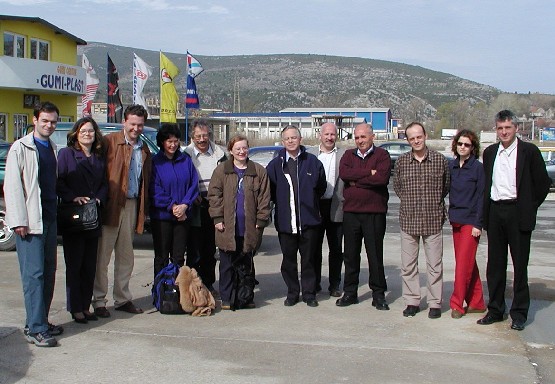
International
projects in Neretva's lower flow
-
In 1997 within
Ramsar convention the project MedWet-initiations was held on. It
was financed by the European Union fund LIFE and the project
included Neretva's delta area in Croatia. As part of the project
the seminar about social-economical aspects of usning Neretva's
valley was also conducted with participation of the proper
experts and local community.
-
In 1999 started
two years Life program-Third countries, Preparation of the new
way of managing of the Hutovo blato. The aim of the project is
to develop methods for reestablishing of the basic wetland
structure with special accent on fish and birds communities.
-
During 2000
within the Pact of the stability conduction and REReP program (Regional
Environmental Reconstruction Programme for South Eastern
Europe) and with financial help from the Swiss agency for
development and cooperation, the project Supporting of the
cooperation and exchange in the countries of the Mid and East
Europe started, It is leaded by the Regional center of the
enviroment protection for Mid and East Europe. Neretva's lower
flow is one of the areas where the project is conducting and
it's aim is to develop regional cooperation for the nature
protection area by fortification of the civil society
institutions.
Via that program ungovernment local organizations conducted
during 2001 few valuable small projects.
Jaroslav VEGO
Jasminka RADOVIĆ
-
|
![[University of Mostar]](grb.jpg)




